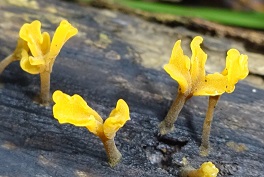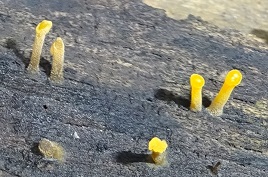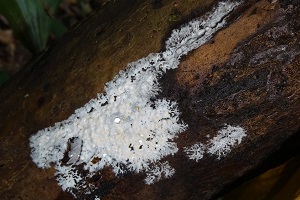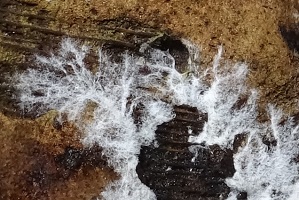| Home | Nature Weekly Index |
5 June 2016 | Mushroom (Fungus) | Ramaria fumigata | Dacryopinax spathularia |
.jpg)
.jpg) I have been watching the on-and-off appearance of a coral-like fungus in my pot that housed the
Acacia auriculiformis (Common Acacia) for a long time but was
unable to find a clue on what fungus group it belonged to. The 3 pots of Common Acacia started from seeds of unknown origin
back in 2010. Two of them died after I trimmed them in
March last year due to the painting work outside of my flat.
A few weeks back, I finally got a breakthrough on the identity of the
fungus (Ramaria fumigata) when I found
an article from India published in 2013
that specifically described a fungus that was associated with the Common Acacia. It was a coral fungus from the family
Gomphaceae. The fungus was dark greyish purple in colour that appeared in the pot when the weather was wet and cooler. It
usually reached a height of 2 to 3 centimetres. I had kept one of the dead tree trunks standing erected in the pot with
other smaller plants growing around it but no coral fungus had appeared since the tree was dead while the live version
continued to host the fungus from time to time. It was quite clear that the fungus could only survive with a living Common
Acacia.
I have been watching the on-and-off appearance of a coral-like fungus in my pot that housed the
Acacia auriculiformis (Common Acacia) for a long time but was
unable to find a clue on what fungus group it belonged to. The 3 pots of Common Acacia started from seeds of unknown origin
back in 2010. Two of them died after I trimmed them in
March last year due to the painting work outside of my flat.
A few weeks back, I finally got a breakthrough on the identity of the
fungus (Ramaria fumigata) when I found
an article from India published in 2013
that specifically described a fungus that was associated with the Common Acacia. It was a coral fungus from the family
Gomphaceae. The fungus was dark greyish purple in colour that appeared in the pot when the weather was wet and cooler. It
usually reached a height of 2 to 3 centimetres. I had kept one of the dead tree trunks standing erected in the pot with
other smaller plants growing around it but no coral fungus had appeared since the tree was dead while the live version
continued to host the fungus from time to time. It was quite clear that the fungus could only survive with a living Common
Acacia.

 Compared to Ramaria fumigate,
Dacryopinax spathularia (Fan-shaped Jelly Fungus)
was a far more common and well-known fungus with its bright orange fruiting bodies, making it hard to miss when they sat
on top of rotting wood. I just found an emerging colony on a fallen decomposing tree trunk in the park last week. The
jelly-like fruiting body grows in clusters or in rows usually along cracks on rotting wood. Its overall appearance was
fan-shaped with rounded stalks at the base and flattened upward. It seemed that the Chinese consumed this fungus known as
Gui Hua Er (桂花耳) in Chinese term. However, some websites had indicated its edibility as unknown.
Compared to Ramaria fumigate,
Dacryopinax spathularia (Fan-shaped Jelly Fungus)
was a far more common and well-known fungus with its bright orange fruiting bodies, making it hard to miss when they sat
on top of rotting wood. I just found an emerging colony on a fallen decomposing tree trunk in the park last week. The
jelly-like fruiting body grows in clusters or in rows usually along cracks on rotting wood. Its overall appearance was
fan-shaped with rounded stalks at the base and flattened upward. It seemed that the Chinese consumed this fungus known as
Gui Hua Er (桂花耳) in Chinese term. However, some websites had indicated its edibility as unknown.

 With the wetter weather recently, I did see quite a few types of mushrooms last week in the park but they were mostly
bracket fungi (Order: Polyporales). Something that I was more interested were patches of whitish materials that covered
some parts of a log. Though they might look like hyphae of mushroom, it was more likely to be a slime mould based on
my past encounters with these non-mushroom organisms and also,
mushroom hyphae do not typically appear on exposed surfaces. After examining the pictures more closely in magnification
mode, I think it should indeed be a slime mould. The overall appearance looked similar to the famous yellow “intelligent”
slime mould (Physarum polycephalum) that was a favourite research materials for different fields except that the
one I saw was white in colour. The closest I could get to a potential identity was Brefeldia maxima
(Tapioca Slime Mould).
With the wetter weather recently, I did see quite a few types of mushrooms last week in the park but they were mostly
bracket fungi (Order: Polyporales). Something that I was more interested were patches of whitish materials that covered
some parts of a log. Though they might look like hyphae of mushroom, it was more likely to be a slime mould based on
my past encounters with these non-mushroom organisms and also,
mushroom hyphae do not typically appear on exposed surfaces. After examining the pictures more closely in magnification
mode, I think it should indeed be a slime mould. The overall appearance looked similar to the famous yellow “intelligent”
slime mould (Physarum polycephalum) that was a favourite research materials for different fields except that the
one I saw was white in colour. The closest I could get to a potential identity was Brefeldia maxima
(Tapioca Slime Mould).